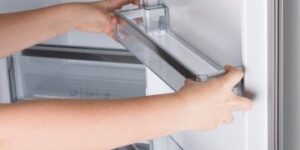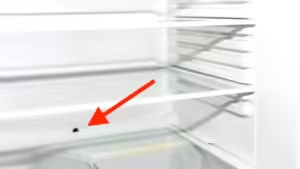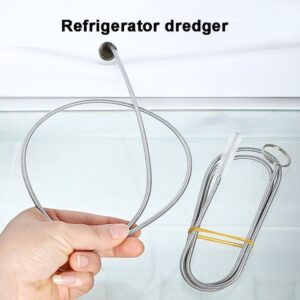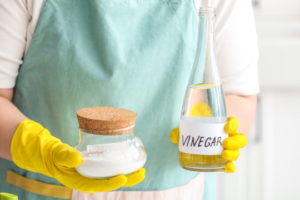Drainage Hole In Fridge
Drainage Hole Fridge
A blocked fridge drain is a common problem that can lead to water pooling at the bottom of your refrigerator or even causing leaks onto your kitchen floor. Thankfully, unblocking a fridge drain is a simple task that requires minimal tools. In this blog, we’ll guide you through the process and cover all the necessary steps.
Prevention is Key
Regular cleaning of the fridge drain and removing food debris can stop blockages before they start.

What is a Fridge Drain?
A fridge drain, also known as a drainage hole, plays a critical role in the efficient operation of your refrigerator. During the fridge’s cooling cycle, condensation naturally forms inside the appliance and excess moisture needs to be expelled to maintain optimal performance. This is where the fridge drain comes in.
The drain hole is typically located at the back, near the base of the fridge’s interior. It channels water from condensation or defrosting into a tray located underneath the fridge. From there, the water evaporates harmlessly. However, when this drain becomes clogged with food particles, ice or dirt, it can lead to water backing up into the fridge, which may cause leaking, water pooling, or inconsistent cooling.
A well-functioning fridge drain hole ensures that moisture is removed efficiently, keeping your fridge dry and preventing potential mold growth or other issues related to excess moisture. Proper maintenance and regular cleaning of the fridge drainage hole help avoid these blockages and keep your refrigerator running smoothly.
Knowing how to properly unblock and maintain the drain is crucial for extending the life of your fridge and ensuring it remains efficient.
What Causes a Fridge Blocked Drain?
There are several reasons why a fridge drain can become blocked, resulting in water pooling or leaking inside your refrigerator. Understanding these causes can help you prevent future blockages:
Food Debris
One of the most common causes of a blocked fridge drain is food particles. Small bits of food, crumbs, or even liquid spills can find their way into the drainage hole and obstruct it. Over time, this buildup can become compacted, making it difficult for water to drain properly.Ice Buildup
Sometimes, ice can form in or around the fridge drain hole, particularly in older models or fridges that experience temperature fluctuations. When the fridge defrosts, if the drain hole is blocked by ice, the water cannot drain and begins to pool at the bottom of the fridge.Dust and Dirt
Over time, dust and dirt can accumulate in the drain hole. This can happen if the fridge is not cleaned regularly or if there is excess dust in the surrounding environment. Dirt can mix with condensation water and create a sludge that blocks the drain.Incorrect Temperature Settings
Setting your fridge to a very low temperature may cause excessive frost or ice to form, which can eventually block the drainage hole. On the other hand, higher temperatures can lead to more condensation, increasing the risk of blockages if the drain is partially obstructed.Improper Sealing of Food
If food containers are not properly sealed, liquids or even moist air from certain food items (like fruits and vegetables) can drip into the fridge drain, leading to blockages. This is especially true for uncovered or open food containers that release excess moisture.Clogged Drain Tray
The drain tray, located at the back or underneath the fridge, collects the water that drains out. If the tray is full of water or debris, it can disrupt the entire drainage process and cause a backup, leading to a blocked drain inside the fridge.Mold and Bacterial Growth
In humid environments or if the fridge isn’t cleaned regularly, mold or bacteria can grow around the drain hole, contributing to blockages. This can also lead to foul odors and hygiene issues.
Being aware of these common causes can help you take preventive measures, such as regularly cleaning the fridge drain hole, covering food properly and checking for ice buildup. Regular maintenance and monitoring will go a long way in keeping your fridge drain clear and functioning efficiently.
Signs Your Fridge Drain is Blocked
Before diving into the solution, it’s essential to recognise the signs of a blocked fridge drain:
- Water pooling: This is one of the most obvious symptoms, usually seen at the bottom of the fridge compartment.
- Damp food packaging: If you notice your food containers getting wet or soggy, it could be due to water backup.
- Unpleasant odors: A clogged drain can lead to a buildup of stagnant water, which might start to smell over time.
- Inconsistent cooling: A blockage can disrupt the fridge’s cooling cycle, potentially spoiling your food.
How to Locate the Fridge Drain Hole
Fridge drain holes are typically located at the back of the fridge, near the bottom. It’s designed to channel condensation and defrost water into a tray beneath the appliance, where it evaporates. Different fridge models may have slight variations in the location, so consult your fridge’s manual if you’re unsure.
How To Unblock Fridge Drain
Step By Step

1. Power Off the Fridge
Before starting any repair or cleaning, unplug your fridge to ensure safety. If the fridge needs to be moved to access the drain more easily, do so carefully.

2. Remove Shelves and Drawers
Take out the shelves and drawers to give yourself easy access to the drain hole. Clean the area of any spilled liquids or food debris.

3. Locate and Inspect the Drainage Hole
Once the shelves are out, find the drainage hole in the fridge. Inspect it closely to see if it’s visibly blocked by dirt, food particles, or ice buildup.

4. Unblock the Drain
Method 1Using a pipe cleaner or a straw: Push a flexible tool, like a pipe cleaner or drinking straw, into the drain to clear any blockages. Move it around gently to dislodge any debris.

4. Unblock the Drain
Method 2Hot water method: If the drain is still clogged, try pouring hot (but not boiling) water into the hole to melt any ice and break down food debris. You can use a turkey baster or a syringe to direct the water precisely.

4. Unblock the Drain
Method 3Baking soda and vinegar: For a more thorough clean, mix baking soda and vinegar, and pour it down the drain hole. This natural cleaning solution helps dissolve stubborn clogs while neutralising odors.

5. Clean the Drain Tray
Check the tray at the back or underneath the fridge, where the drained water collects and evaporates. Empty and clean it to prevent future clogs.

6. Reassemble and Turn the Fridge Back On
Once everything is clean and dry, reassemble the shelves and drawers. Plug the fridge back in, and monitor it over the next few hours to ensure the problem is resolved.
Preventive Measures to Avoid
Fridge Drain Hole Blocked
- Regular Cleaning: Regularly cleaning your fridge and keeping the drainage hole free of dirt and debris can prevent future blockages.
- Check for Ice Build-up: Ice can form over time in your fridge’s drainage hole. Keep an eye out for frost or ice buildup and defrost the fridge as needed.
- Avoid Spilling Liquids: Try to avoid spilling liquids inside the fridge, and immediately clean any spills to prevent them from entering the drainage hole.
By following these steps, you can efficiently unblock your fridge drain and ensure it continues to function optimally. Remember to keep up with regular cleaning and preventive maintenance to avoid blockages in the future.
Keep Your Cool with Perfect Drainage!
Need a hand?
Contact us today for a quick inspection and expert maintenance. Don’t let a small issue turn into a big problem—act now!


